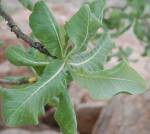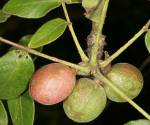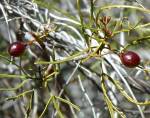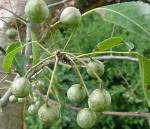Commiphora
Commiphora Jacq.
Family: Burseraceae
Common names: corkwood, commiphora; (Eng.); kanniedood (Afr.)
Introduction
The corkwoods are a fascinating group of trees, because of their bizarre appearance, but more importantly for their historical and biblical association as providers of the earliest healing balms and fragrances.

The fact that many Commiphora species exude a resin with a pleasant odour and healing properties has been known since ancient times. Best known are the plants that produce myrrh and balm. Myrrh from Commiphora myrrha is mentioned in the Bible as one of the three gifts presented to the Christ child by the Wise Men. Commiphora gileadensis relates to the 'Balm of Gilead', which was used for its fragrance as well as healing properties.
Description
Description
The diversity within the genus makes it difficult to give a general accurate description and single out defining features.
Corkwoods are multi-stemmed shrubs or trees with stems branching repeatedly at ground level, or trees with a single upright stem, often spiny, with smooth or papery bark. Species from arid areas often have a swollen, nearly succulent trunk. Branchlets are often spine-tipped. Leaves vary between simple and compound, 1- to 3-foliolate or pinnate. Small white inconspicuous flowers are produced in axillary panicles or on dwarf lateral shoots. The sexes are separate with different male and female trees. All parts of the flower are in fours. Round or ovoid fruits with thin flesh are produced. The fruits split into two sections when ripe, revealing the stone (seed) with a brightly coloured fleshy appendage (the pseudo-aril).

Commiphora species are deciduous and for most of the year the trees are without leaves, making identification difficult. Bark characteristics are then used to identify the trees.
The bark of most species peels off in papery pieces and flakes, often with a greenish layer underneath. Some bark is corky, while other species have variable bark.
All species exude a milky or watery sap when damaged. Most species produce aromatic resin, a gum-like substance which hardens as it runs down the stem.

The genus name Commiphora originates from the Greek words kommi meaning 'gum' and phoros meaning 'bearing'. It was first used in 1797 by Jacquin who described the first specimen from Madagascar.
Conservation Status
Status
All southern African species are listed as LC (Least concern), which means that the group is not at risk. No significant threats to the plants are known.
Some species in India are threatened from over-harvesting and habitat destruction.
Distribution and habitat
Distribution description
Over 200 species are recorded in the genus and occur in Africa, Arabia, the Indian Ocean islands and India. There are two centres of diversity; one in northern Namibia and one in North-East Africa. In Southern Africa 38 species are found naturally (including subspecies). 25 species occur in Madagascar.
Most species grow under hot and arid conditions in Africa and Arabia. A few species occur in forests.
Ecology
Ecology
Corkwood trees are typical of arid and hot landscapes and fulfil an important role in providing moisture and food in such inhospitable areas. The flowers are pollinated by small insects and the fruit are eaten by birds and small mammals. Many species of corkwood store water in the swollen lower part of their stems and these are utilized by animals for the moisture. The leaves of some species are browsed by game.
The gum-like resin has a strong taste, and is probably a deterrent to excessive damage.
Some Commiphora species are favoured by elephants and in some areas the trees are destroyed in great numbers. In the Mapungubwe National Park, in northern Limpopo Province, for example, the damage to these trees is severe. Often the very old trees are targeted and almost destroyed completely.

Uses
Use
Most of the corkwood species produce aromatic resins. C. myrrha from Arabia produces a fragrant resin, which is used medicinally and as incense. C. gileadensis from Arabia and north-east Africa provides the medical resin 'Balm of Gilead'.
An Indian species Commiphora wightii is used in the treatment of diseases in Ayurveda, the traditional medicine of India. Unfortunately the plant has become endangered because of its slow growth rate, poor seed germination rate and excessive and unscientific tapping for its gum resin by the pharmaceutical industries and religious prophets.
The gum of C. pyracanthoides is boiled in water to form a soap for washing clothes, and the resin from the stem is used as a hair straightener. The twigs of C. multijuga are used as toothbrushes in Kaokoland.

Some Commiphora species in South Africa have edible fruit. The leaves are browsed by game and livestock. The wood is used for the bottom stick when making fire with friction. Some species store water in their stem and roots, and water can be extracted by sucking and chewing roots. Poles are used for ceremonial purposes.
The common name corkwood indicates that the wood is soft, although it is suitable for carving household items and ornaments. The Afrikaans name kanniedood ('cannot die') refers to the fact that cut branches or cuttings grow very easily when planted.
The poison beetle larvae (of the genus Diamphidia) feed on Commiphora species and are used as poison by the San in the Kalahari.
As a child in the north of Namibia, I remember that a Commiphora species (probably C. pyracanthoides) was used as a Christmas tree, because it lasted very long after being chopped off, when kept in a container with water. It also had just the perfect arrangement of twigs to hang the decorations on!
More uses are mentioned in the species descriptions below.
Species

Commiphora anacardiifolia Dinter & Engl. – large-leaved corkwood; grootblaarkanniedood.
SA Tree no. 271
Thickset tree with single trunk. Spreading crown. Papery peeling bark. Large stalkless leaves, glossy green with clear venation. Occurs in northern Namibia, against mountain slopes on the fringe of the Namib desert. In Kaokoland the wood is used to carve household utensils.

Commiphora edulis (Klotzsch) Engl. – rough-leaved corkwood; skurweblaar kanniedood.
SA Tree no. 275
Small much-branched tree. Bark not peeling. Leaves compound, rough to the touch due to stiff hairs. Large red fruit are eaten by birds, rodents and monkeys, but not favoured by humans. Occurs in dry, hot bushveld in the northern parts of South Africa up to northern Zimbabwe.

Commiphora gracilifrondosa Dinter ex J.J.A.van der Walt – karee corkwood, stink corkwood; karee kanniedood, stinkkanniedood, suikerkan. SA Tree no. 284
Thickly-stemmed shrub-like tree with fat, succulent appearance. Bark is red-brown and shiny, not peeling. Leaves slender 3-foliolate with toothed margins. Very strong and pleasant smelling resin exuded when damaged. Wood has a sweet taste when chewed, hence the name ‘suikerkan'. Occurs in arid rocky mountains in Northern Cape and Richtersveld.

Commiphora harveyi (Engl.) Engl. – red-stemmed corkwood, copper-stem corkwood; rooistamkanniedood, koperstamkanniedood.
SA Tree no. 277
Medium-sized tree. Stem upright and bark peeling in large papery, coppery-bronze disks. Large compound leaves, turn yellow before falling. Fences are easily grown from poles cut from this tree. Monkeys and bird eat the seeds. The soft heartwood is chewed to quench thirst. Makes good bonsai tree. Found in bushveld, dry woodland and coastal dune forest in KwaZulu-Natal.
References
- COATES PALGRAVE, M. 2002. Keith Coates Palgrave Trees of southern Africa, edn 3. Struik, Cape Town.
- Final Project Report of In-situ conservation of Commiphora wightii a red-listed medicinal plant species of Rajasthan State, India. Principal Investigator: Dr. Vineet Soni. 2008. IUCN, Species Survival Commission.
- POOLEY, E. 1993. The complete field guide to trees of Natal, Zululand and Transkei. Natal Flora Publications Trust, Durban.
- SMITH, C.A. 1966. Common names of South African plants. Memoirs of the Botanical Survey of South Africa No. 35.
- STEYN, M. 2003. Southern African Commiphora. Privately published by the author.
- VAN DER WALT, J.J.A. 1973. The South African species of Commiphora. Bothalia 11,1 & 2: 53 - 102.
- VAN WYK, B. (A.E.); VAN WYK, P. & VAN WYK, B-E. 2000. Photographic guide to trees of southern Africa. Briza Publications, Pretoria.
- VAN WYK, B-E. & GERICKE, N. 2000. People's plants: a guide to useful plants of southern Africa. Briza Publications, Pretoria.
- VENTER, F. & VENTER, J-A. 1996. Making the most of indigenous trees. Briza Publications, Pretoria.
Credits
Beate Hölscher
National Herbarium Pretoria
January 2011
Plant Attributes:
Plant Type: Shrub, Tree
SA Distribution:
Soil type:
Flowering season:
PH:
Flower colour:
Aspect:
Gardening skill:
Special Features:
Horticultural zones






Rate this article
Article well written and informative
Rate this plant
Is this an interesting plant?
Login to add your Comment
Back to topNot registered yet? Click here to register.